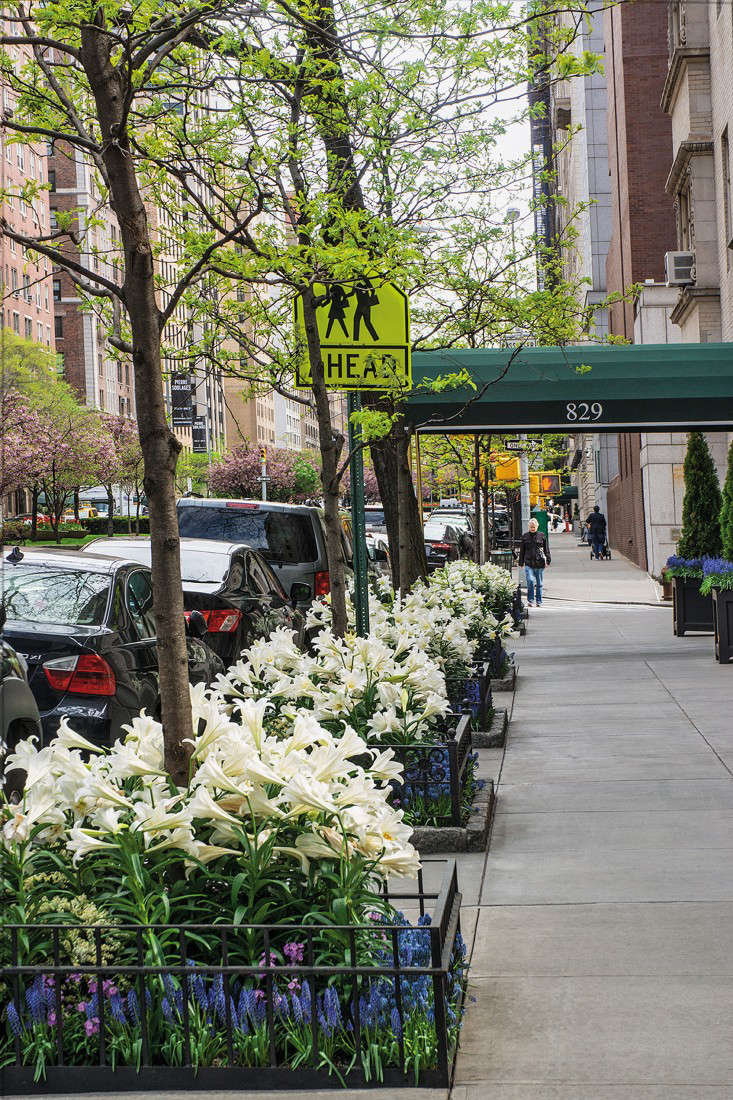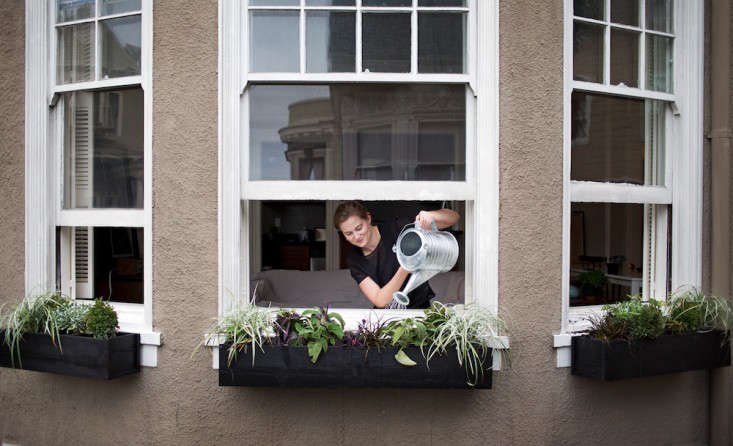Sometimes the neglected patch of dirt surrounding a street tree is all the dirt you have. Some city gardeners have backyards and front gardens, but for others a sidewalk tree bed is the garden. Transforming a tree bed into a postage stamp of color will create curb appeal—as documented by photos Betsy Pinover Schiff took of tree beds across New York City for the soon-to-be-released book, Sidewalk Gardens of New York.
Her photos inspired us to ask Maureen O’Brien, the Brooklyn Botanic Garden’s community field manager who judges the tree bed category for the annual Brooklyn’s Greenest Block Contest, for tree bed planting tips. Here’s everything you need to know to turn a sidewalk tree bed into a city garden:
Photography by Betsy Pinover Schiff, courtesy of Monacelli Press.
What is a tree bed?
Above: A tree bed is the opening in the sidewalk where a tree is planted. The bed allows water to reach the roots of the tree which can extend under the concrete many feet away from the tree’s base.
Why plant a tree bed?
Above: If done correctly, a tree bed with added plants can benefit the tree as well as beautify the streetscape. According to Maureen O’Brien, community field manager at the Brooklyn Botanic Garden’s Greenbridge neighborhood outreach project, tree beds with plants help to keep the soil and tree roots cool in summer, are a reminder to water, and help to prevent soil compaction.
Before you plant:
Above: Not all tree beds are good candidates for gardening, especially if the resident tree is a very large old one. Your first step should be to determine if there is enough room in the bed to add plants. Take a small hand cultivator and gently explore the top layer of soil. Is the bed so crowded with tree roots that you can’t find empty areas where plant roots could go?
If so, O’Brien advises foregoing plants and simply adding a 1- to 2-inch layer of organic mulch. The mulch will give the bed a cared-for appearance and add nutrients to the soil as it breaks down over time. Be careful to not allow the mulch to touch the bark of the tree or any big gnarly roots. That could cause damage and compromise the health of the tree. Make sure to leave at least 8 inches of space between the mulch and the trunk.
Preparing the soil:
Above: On the subject of soil, O’Brien is adamant. She says, “The biggest mistake people make with tree beds is adding soil.” She explains that piling up soil so that it is high on the trunk of the tree could rot the bark and invite damage from harmful insects and rodents. And because most tree roots are in the top 18 inches of soil, adding dirt can interfere with the crucial uptake of oxygen. Although the soil in tree beds is often poor, it is not advisable to add nutrients such as fertilizer. If you do, the roots of the tree will tend to stay in the amended area and not spread out as they should. A small amount of compost (1/4 inch to 1/2 inch per year) is all the added nutrition your bed should need.
Choosing the Right Plants:
Above: The ideal plants for tree beds are petite annuals or perennials that have small root systems. O’Brien, who judges the finalists in the tree bed category for the venerable Brooklyn’s Greenest Block Contest, advises against woody plants such as roses and shrubs. She warns they will take more than their share of water. Sunflowers should be avoided for the same reason, as should ivy which can also compromise tree health by climbing up the trunk. (A warning to city gardeners, ivy is a favored habitat for rats.)
If the plant label says “drought tolerant,” chances are it will be a good addition to your tree bed. Native plants have the added advantage of attracting pollinators such as birds and butterflies, but beware of those such as Queen Anne’s Lace which have long taproots. Choose bee balm (Monarda didyma) or columbine (Aquilegia) instead.
Plant Palette Ideas:
Above: Low-growing ground covers make a good living mulch. Wild thyme (Thymus serpyllum), mint (Mentha), bugleweed (Ajuga reptans) and periwinkle (Vinca minor) work well. Add some dramatic flowering plants for color and you will have a winning plant combination in your tree bed. Marigolds (Tagetes species), nasturtium (Tropaeolum species), rock rose (Portulaca species), and zinnias (Zinnia angustifolia) will bring life to the sunny bed of a young tree. Select begonia (Begonia x semperforens), coleus (Solenostemon scutellarioides), and lobelia (Lobelia erinus) for color in the shade of a mature tree.
Seasonal Color:
Above: Because they bloom before most trees leaf out, spring bulbs are a good choice and provide early color. Snow drops (Galanthus nivalis), crocus (Crocus species), grape hyacinth (Muscari species) and daffodil (Narcissus species) are pretty and reliable. In shade, interplant them with ferns or hostas which will appear as the bulbs are fading and cover their dying foliage. Find more plant suggestions on this Plants for Tree Beds tip sheet from BBG.
Tree Guards:
Above: You may want to add a tree guard to give your bed a finished look and send a message to passersby that the bed should be respected. It is a garden and not a place to throw trash or to walk through or to serve as a dog’s restroom.
Tree guards can be homemade or purchased. In some places guards can be obtained through local governments or neighborhood organizations. Many municipalities have regulations that specify the design, height, material, and dimensions of tree guards. Some places, like New York City, require a tree guard permit before installation. It is important that tree guards not present a tripping hazard for people on the sidewalk and that the curb side of the guard is left open to prevent damage to car doors. Good tree guards allow water to flow freely through them so the tree is not drowned in standing water.
Tree Bed Maintenance:
Above: The better groomed your tree bed appears, the more likely people will respect it. Even if you have (wisely) chosen low maintenance plants it is still important to deadhead, prune, and weed. However, the most important part of caring for a tree bed is watering. According to O’Brien, a newly planted tree can require as much as 20 gallons of water a week. This can present a challenge since it is really impossible to set up irrigation in a tree bed. A faucet installed at the front of your house is ideal and allows you to water the bed with a hose. Sometimes devices such as Treegators, plastic bags with holes that allow the slow flow of water into the soil, are used for young trees up to 8 inches in diameter. If you have to bring water to the bed in containers, make sure to water thoroughly. Deep watering encourages roots to grow down instead of staying on the surface where they are more prone to be damaged. Consult this BBG tip sheet for more information on tree bed maintenance.
Above: Good luck adding a bit of greenery to your city sidewalk. For more ideas, on urban greening you can pre-order Sidewalk Gardens of New York (which will be published on September 13) for $28.13 from Amazon.
For more ways to create curb appeal in a city garden, see Curb Appeal: 11 Front Garden Ideas to Steal from Brooklyn and Garden Visit: Summit Street Garden in Brooklyn.




















Have a Question or Comment About This Post?
Join the conversation